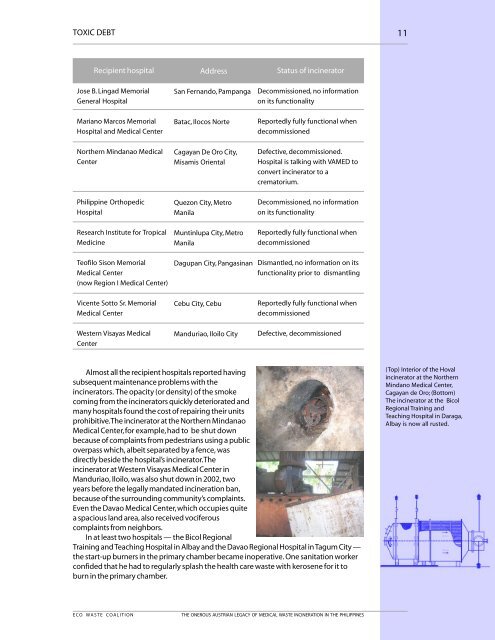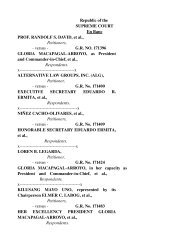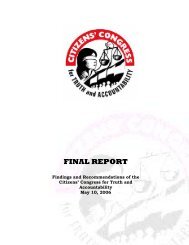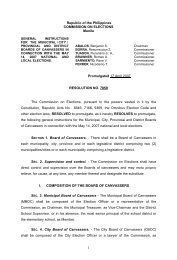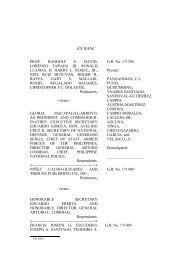Ecowaste Coalition - Philippine Center for Investigative Journalism
Ecowaste Coalition - Philippine Center for Investigative Journalism
Ecowaste Coalition - Philippine Center for Investigative Journalism
You also want an ePaper? Increase the reach of your titles
YUMPU automatically turns print PDFs into web optimized ePapers that Google loves.
TOXIC DEBT<br />
11<br />
Recipient hospital<br />
Jose B. Lingad Memorial<br />
General Hospital<br />
Mariano Marcos Memorial<br />
Hospital and Medical <strong>Center</strong><br />
Northern Mindanao Medical<br />
<strong>Center</strong><br />
<strong>Philippine</strong> Orthopedic<br />
Hospital<br />
Research Institute <strong>for</strong> Tropical<br />
Medicine<br />
Address<br />
San Fernando, Pampanga<br />
Batac, Ilocos Norte<br />
Cagayan De Oro City,<br />
Misamis Oriental<br />
Quezon City, Metro<br />
Manila<br />
Muntinlupa City, Metro<br />
Manila<br />
Status of incinerator<br />
Decommissioned, no in<strong>for</strong>mation<br />
on its functionality<br />
Reportedly fully functional when<br />
decommissioned<br />
Defective, decommissioned.<br />
Hospital is talking with VAMED to<br />
convert incinerator to a<br />
crematorium.<br />
Decommissioned, no in<strong>for</strong>mation<br />
on its functionality<br />
Reportedly fully functional when<br />
decommissioned<br />
Teofilo Sison Memorial<br />
Medical <strong>Center</strong><br />
(now Region I Medical <strong>Center</strong>)<br />
Dagupan City, Pangasinan<br />
Dismantled, no in<strong>for</strong>mation on its<br />
functionality prior to dismantling<br />
Vicente Sotto Sr. Memorial<br />
Medical <strong>Center</strong><br />
Western Visayas Medical<br />
<strong>Center</strong><br />
Cebu City, Cebu<br />
Manduriao, Iloilo City<br />
Reportedly fully functional when<br />
decommissioned<br />
Defective, decommissioned<br />
Almost all the recipient hospitals reported having<br />
subsequent maintenance problems with the<br />
incinerators. The opacity (or density) of the smoke<br />
coming from the incinerators quickly deteriorated and<br />
many hospitals found the cost of repairing their units<br />
prohibitive. The incinerator at the Northern Mindanao<br />
Medical <strong>Center</strong>, <strong>for</strong> example, had to be shut down<br />
because of complaints from pedestrians using a public<br />
overpass which, albeit separated by a fence, was<br />
directly beside the hospital’s incinerator. The<br />
incinerator at Western Visayas Medical <strong>Center</strong> in<br />
Manduriao, Iloilo, was also shut down in 2002, two<br />
years be<strong>for</strong>e the legally mandated incineration ban,<br />
because of the surrounding community’s complaints.<br />
Even the Davao Medical <strong>Center</strong>, which occupies quite<br />
a spacious land area, also received vociferous<br />
complaints from neighbors.<br />
In at least two hospitals — the Bicol Regional<br />
Training and Teaching Hospital in Albay and the Davao Regional Hospital in Tagum City —<br />
the start-up burners in the primary chamber became inoperative. One sanitation worker<br />
confided that he had to regularly splash the health care waste with kerosene <strong>for</strong> it to<br />
burn in the primary chamber.<br />
(Top) Interior of the Hoval<br />
incinerator at the Northern<br />
Mindano Medical <strong>Center</strong>,<br />
Cagayan de Oro; (Bottom)<br />
The incinerator at the Bicol<br />
Regional Training and<br />
Teaching Hospital in Daraga,<br />
Albay is now all rusted.<br />
ECO WASTE COALITION<br />
THE ONEROUS AUSTRIAN LEGACY OF MEDICAL WASTE INCINERATION IN THE PHILIPPINES


